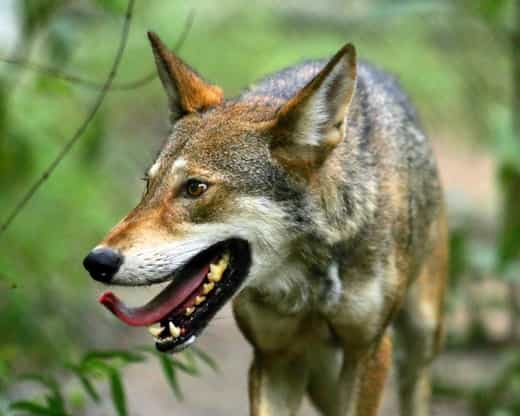Red Wolf

Red wolf is a canine and the world’s most endangered wolf. Their body is covered with tawny, reddish fur. Red wolves are intermediate in size between the coyote and grey wolf. The scientific name is Canis rufus and belongs to the family Canidae, red wolf is native to the United States. In 1967, the red wolf was extinction under the Endangered Species Preservation Act of 1966 but currently they are listed as an endangered species by the Fish and Wildlife Service under the Endangered Species Act of 1973. The International Union for Conservation of Nature (IUCN) listed the red wolf as a critically endangered species since 1998. Recent research suggests that the red wolf is a unique species. They have been compared to the domestic German shepherd due to their relatively long and slender limbs. Despite being large in size, they are often mistaken for coyotes. Red wolf gets its common name for its reddish coat.
Description of Red Wolf

Red wolf has generally towny or brown, reddish fur with some black fur along its back and light markings around its mouth and eyes. Sometime a reddish tinge can be seen on their head, ears and legs. The size of a red wolf is between the size of a grey wolf and a coyote. The adult red wolf is about 4 feet long from the nose to the tip of its tail and can grow up to 2 feet tall, weighing about 45pound to 80pound. The average weight of a female red wolf is 60 pounds. Red wolf has large head, long slender legs, large, pointy ears, broad muzzles.
Their almond shaped eyes are closer to the face and oblique. The colors of their eyes are amber or pale yellow or even green. Their eyes glow in the dark because they have a special light reflecting surface with special layer of reflective cells behind their retinas, called tapetum lucidum that helps them to see clearly in the dark. When the light enters the eyes, sometimes it does not hit the photoreceptor and the tapetum lucidum act as a mirror and reflects the light back. This not only helps the wolves to see at night but also creates the eye shine at night. Their eyes are not actually glowing at night, only the light is reflected. Their retina has two types of cells called rods and cones. Rod cells are sensitive to light and allow to see objects in low light. The cone cells have a variety of pigments that help the wolves to perceive color. As the cone cells work in bright light, these are not effective at night but these cells can detect more detail than rod cells.
Red wolf’s hearing and sense of smell is very strong and able to smell thing from about 100 times greater than humans. Red wolves are very much protective of their territory and mark their territory with urine and scats which is called scent-marking and they do it every 2 minutes. When the pack members enter a new territory, they smell the scents and can understand that the area is already occupied. When the wolves do scent-markings, they raise one leg, this effective dominant posture uses many forms of communication which is called “Raised Leg Urination” or RLU.
Red wolves’ sense of smell helps them to communicate through chemical messages between members of the same species. These chemical messages are known as pheromones. Pheromones secret in red wolf from their glands on the toes, tail, eyes, anus, genitalia and skin. Pheromones help the wolves to find their mates.
Red wolves are social animals and live-in packs. Each pack has 5 to 8 wolves, a breeding adult pair called alpha male and alpha female and their offspring of different ages. Alpha males and alpha females dominate all other wolves in the pack. Red wolves are shy and normally avoid humans. They are most active at dusk and dawn. When the alpha male or female is killed or trapped, then another adult wolf comes to replace the one who died.
Sounds created by red wolves can be separated into 4 categories like barking, howling, growling and whimpering. They bark when they sense danger or show aggression in defense and also a warning. Growling and barking are used as warning at predators or to indicate dominance. Howling is used to keep the pack together and to locate one another and also strangers away. Red wolves communicate by using body language include ear and tail positioning, facial expressions, ears sticking straight, teeth bared and wrinkled snout are signs of threatening messages. Red wolf can live 6 to 7 years in the wild and around 14 years in captivity.
Reproduction of Red Wolf
Red wolves are monogamous means mate for life. When they reach at the age of three, they become sexually mature. They breed once a year and mate from January to early March. They make their dens in the base of hollow trees and logs or rock caves and also dig the soil to make their dens. They prefer the areas close to the water. Pregnant wolf digs the soil to make the den a few weeks before giving birth to the pups. After 60 days of gestation period, female red wolf gives birth 2 to 8 pups. The pups are well hidden in the den and the adult wolves of the pack tend to lie on higher areas to guard the den and only mother can enter the den. They use the same den year after year. The pups are blind and communicate by grunt and squeak and explore by smell and touch. Then the pups only depend on mother’s milk. When they reach 5 to 10 weeks, they have tiny sharp teeth. Now the parents and the adult pack members regurgitate food for the pups to eat. The mother red wolf and the pack members keep a watchful eye on them. When the pups reach 4 to 8 months, they learn hunting by watching the adults. They grow fast and at the age of only 7 months, they look a lot like adults.
Where do Red Wolves Live?
The red wolf native to the southeastern United States. Once red wolf lives throughout the southeastern United States and their range extended from the Atlantic and Gulf coast, northern part of the Ohio River Valley, central Pennsylvania, western part of Central Texas and southeastern Missouri. Now the red wolf can find only in five countries on the Albemarle Peninsula of eastern North Carolina. Once there were 100 red wolves but now 70% of the population has declined. Now wild population of red wolves are found only in North Carolina. Now only 10 red wolves survive in the wild and about 175 in captivity.
What do Red Wolves Eat?
Red wolves are carnivores. However, their diet depend on what prey is available. They prefer to hunt smaller prey like rabbit, rodents, raccoons, white-tailed deer. Occasionally they eat berries and insects. Red wolves are nocturnal and mostly active at night. Red wolves can eat up to 5 pounds of food in one sitting. They also eat carrion.
Why is the Red Wolf Endangered?
Red wolf is considered the most critically endangered animal in North America. The main threats to red wolves include habitat loss, illegal hunting, hybridization with coyotes.
Red wolves are endangered because of human activities. Red wolves loss their habitat due to deforestation. Their numbers have been declined due to excessive hunting until 1979. In 1980 only 20 red wolves were left in the wild that’s why they were taken to the zoos.
Hybridization with related species is one of the biggest threats to the red wolf, especially with coyotes. The coyotes went too far to the east and completely replaced the red wolf. Today some full-blooded red wolves are alive but almost all red wolves are hybrids.
Red wolves attack livestock so they are killed by gunshot. Coyotes and red wolves have similar colored coats and size, so the hunters mistakenly think of coyotes as red wolf and kill them. Gunfire wounds are one of the leading causes of death for red wolves.
When the red wolves were initially sent back to the wild, many of them died by car accident but now the death rate due to automobiles is likely to be low.
How many red wolves are left in the world?
Red wolf is a canine and the world’s most endangered wolf. In 1967, the red wolf was extinction under the Endangered Species Preservation Act of 1966 but currently they are listed as an endangered species by the Fish and Wildlife Service under the Endangered Species Act of 1973. The International Union for Conservation of Nature (IUCN) listed the red wolf as a critically endangered species since 1998. Now wild population of red wolves are found only in North Carolina. Now only 10 red wolves survive in the wild and about 175 in captivity.
Are Red Wolves dangerous?
Red wolf is shy and normally avoid humans. The red wolves attacking or killing people is rare. Between 1900–2000, over a 100-year period, only 16 cases were found where wild wolves had bitten people. The wolf attacks humans only when they are provoked, such as when they are trapped or cornered or entered into a den where the puppies live. When there is scarcity of food in the wild, the red wolves attack the livestock of the human. Then they can also attack the humans who try to stop them.
What is Red Wolf?
Red wolf is a canine and the world’s most endangered wolf. The scientific name is Canis rufus and belongs to the family Canidae, red wolf is native to the United States. Recent research suggests that the red wolf is a unique species. Red wolf gets its common name for its reddish coat.
What does a Red Wolf Look Like?
Red wolves are intermediate in size between the coyote and grey wolf. Red wolf has generally towny or brown, reddish fur with some black fur along its back and light markings around its mouth and eyes. Sometime a reddish tinge can be seen on their head, ears and legs. The size of a red wolf is between the size of a grey wolf and a coyote. Red wolf has large head, long slender legs, large, pointy ears, broad muzzles. Their almond shaped eyes are closer to the face and oblique. The colors of their eyes are amber or pale yellow or even green. They have been compared to the domestic German shepherd due to their relatively long and slender limbs.
What Color is a Red Wolf?
Red wolf is a canine and the world’s most endangered wolf. Their body is covered with tawny, reddish fur with some black fur along its back and light markings around its mouth and eyes. Sometime a reddish tinge can be seen on their head, ears and legs.


.jpg)














0 Comentarios:
Post a Comment
Please do not use any abusing words or enter any spam links in the comment box